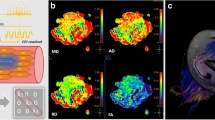Abstract
Magnetic resonance spectroscopy (MRS) can now be performed on routine high-field clinical magnetic resonance imaging systems. Over the last decade it has provided several useful insights into the pathophysiology of mitochondrial disorders. More recently, the feasibility of applications to clinical diagnosis and monitoring have been demonstrated. Exciting new work suggests that carefully supervised physical conditioning in conjunction with sodium dichloroacetate administration can markedly enhance both biochemical measures of aerobic metabolism and functional performance of patients with mitochondrial myopathies.
Sommario
La risonanza magnetica spettroscopica (MRS) può oggi essere effettuata di routine in apparecchi clinici di risonanza magnetica. Nell'ultima decade essa ha fornito importanti informazioni nella patofisiologia dei disordini mitocondriali. Più recentemente sono state dimostrate le sue possibilità di applicazione nella diagnosi clinica e nel monitoraggio di pazienti neurologici. Nuovi ed interessanti studi suggeriscono che un allenamento attentamente supervisionato in congiunzione con trattamento con dicloroacetato è capace di migliorare i parametri biochimici e la performance di pazienti con miopatie mitocondriali.
Similar content being viewed by others
References
Argov Z, Bank WJ, Maris J, Eleff S, Kennaway NG, Olson RE, Chance B.Treatment of mitochondrial myopathy due to complex III deficiency with vitamins K3 and C: A 31P-NMR follow-up study. Ann Neurol, 1986; 19: 598–602.
Arnold DL, Matthews PM, Radda GK.Metabolic recovery after exercise and the assessment of mitochondrial function in vivo in human skeletal muscle by means of 31 P NMR. Magn Reson Med, 1984; 1: 307–315.
Bendahan D, Confort-Gouny S, Kozak-Ribbens G, Cozzone PJ.31-P NMR characterization of the metabolic anomalies associated with the lack of glycogen phosphorylase activity in human forearm muscle. Biochem Biophys Res Commun, 1992; 185: 1621.
De Stefano N, Matthews PM, Ford B, Genge A., Karpati G, Arnold DL.Short-term dichloroacetate treatment improves indices of cerebral metabolism in patients with mitochondrial disorders. Neurology, 1995; 45: 1193–1198.
Eleff S, Kennaway NG, Buist NRM, et al.31 P NMR study of improvement in oxidative phosphorylation by vitamins K3 and C in a patient with a defect in electron transport at complex II in skeletal muscle. Proc Natl Acad Sci USA, 1984: 81: 3529–3533.
Hands LJ, Bore PJ, Galloway G, Morris PJ, Radda GK.Muscle metabolism in patients with peripheral vascular disease investigated by 31 P nuclear magnetic resonance spectroscopy. Clin Sci, 1986; 71: 283–290.
Hayes DJ, Hilton Jones D, Arnold DL, et al.A mitochondrial encephalomyopathy. A combined 31 P magnetic resonance and biochemical investigation. J Neurol Sci, 1985; 71: 105–118.
Hilton-Jones D, Squier MV, Taylor DJ, Matthews PM.Metabolic Myopathies. Saunders, London, 1995.
Karpati G, Arnold D, Matthews P, Carpenter S, Andermann F, Shoubridge E.Correlative multidisciplinary approach to the study of mitochondrial encephalomyopathies. [Review]. Rev Neurol (Paris), 1991; 147: 455–461.
Kemp GJ, Taylor DJ, Thompson CH, et al.Quantitative analysis by 31 P magnetic resonance spectroscopy of abnormal mitochondrial oxidation in skeletal muscle during recovery from exercise. NMR Biomed, 1993; 6: 302–310.
Matthews PM, Williams SR, Seymour AM, et al.A 31 P-NMR study of some metabolic and functional effects of the inotropic agents epinephrine and ouabain, and the ionophore R02-2985 (X537A) in the isolated, perfused rat heart. Biochim Biophys Acta, 1982; 720: 163–171.
Matthews PM, Allaire C, Shoubridge EA, Karpati G, Carpenter S, Arnold DL.In vivo muscle magnetic resonance spectroscopy in the clinical investigation of mitochondrial disease. Neurology, 1991; 41: 114–120.
Matthews PM, Tampieri D, Berkovic SF, et al.Magnetic resonance imaging shows specific abnormalities in the MELAS syndrome. Neurology, 1991; 41: 1043–1046.
Matthews PM, Ford B, Dandurand RJ, et al.Coenzyme Q10 with multiple vitamins is generally ineffective in treatment of mitochondrial disease. Neurology, 1993; 43: 884–890.
Matthews PM, Andermann F, Silver K, Karpati G, Arnold DL.Proton MR spectrocopic demonstration of differences in regional brain metabolic abnormalities in mitochondrial encephalomyopathies. Neurology, 1993; 43: 2484–2490.
Matthews PM, Arnold DL.Coenzyme Q [letter; comment]. Neurology, 1993; 43: 628–629.
Matthews PM, Brown RM, Morten K, Marchington D, Poulton J, Brown G.Intracellular heteroplasmy for disease-associated point mutations in mtDNA: implications for disease expression and evidence for mitotic segregation of heteroplasmic units of mtDNA. Hum Genet, 1995; 96: 261–268.
Penn AM, Lee JW, Thuillier P, et al.MELAS syndrome with mitochondrial tRNA(Leu)(UUR) mutation: correlation of clinical state, nerve conduction, and muscle 31 P magnetic resonance spectroscopy during treatment with nicotinamide and riboflavin. Neurology, 1992; 42: 2147–2152.
Radda GK, Bore PJ, Gadian DG, et al.31 P NMR examination of two patients with NADH-CoQ reductase deficiency. Nature, 1982; 295: 608–609.
Radda GK, Odoom J, Kemp G, Taylor DJ, Thompson C, Styles P.Assessment of mitochondrial function and control in normal and diseased states. Biochim Biophys Acta, 1995: 1271: 1519.
Shevell MI, Matthews PM, Scriver CR, et al.Cerebral dysgenesis and lactic acidemia: an MRI/MRS phenotype associated with pyruvate dehydrogenase deficiency. Pediatr Neurol, 1994; 11: 224–229.
Taivassalo T, Matthews PM, De Stefano N, et al.Combined aerobic training and dichloroacetate improve exercise capacity and indices of aerobic metabolism in muscle cytochrome oxidase deficiency. Neurology, 1996; 47: 529–534.
Author information
Authors and Affiliations
Rights and permissions
About this article
Cite this article
Matthews, P.M., Taivassalo, T. Applications of magnetic resonance spectroscopy to diagnosis and monitoring of mitochondrial disease. Ital J Neuro Sci 18, 341–351 (1997). https://doi.org/10.1007/BF02048237
Issue Date:
DOI: https://doi.org/10.1007/BF02048237




